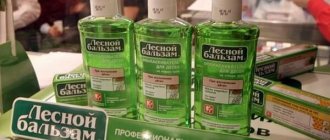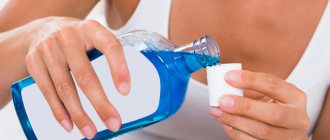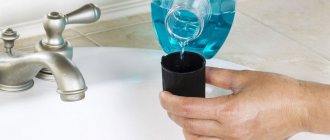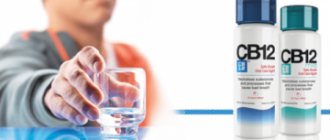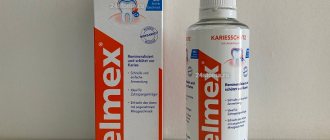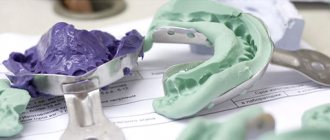Author of the article:
Soldatova Lyudmila Nikolaevna
Candidate of Medical Sciences, Professor of the Department of Clinical Dentistry of the St. Petersburg Medical and Social Institute, Chief Physician of the Alfa-Dent Dental Clinic, St. Petersburg
Oral hygiene is not only regular brushing of teeth in the morning and evening, but also the use of other means to remove bad breath and prevent dental diseases. One of these products is mouthwash. Previously, decoctions of medicinal plants were used in this capacity. Modern medicine offers complex, balanced compositions that have a targeted effect and provide the desired therapeutic or preventive effect.
Purpose of rinses for the mouth and gums
Dentists recommend using these products for:
- Keeping your breath fresh.
- For people who smoke, the components included in the product prevent yellowing of tooth enamel, and also reduce the destructive effect of nicotine and tar on tooth enamel.
- Reducing the effect of “staining” of the enamel as a result of frequent consumption of coffee, tea, wine and other drinks that affect the color of teeth.
- To reduce inflammation in the gums and reduce their bleeding.
- Reduced enamel sensitivity.
Also recommended for use:
- People who suffer from various oral diseases.
- Patients who have braces, dentures or any other structures in the oral cavity.
- After operations in the oral cavity (tooth extraction, installation of implants, etc.).
It must be taken into account that rinses are used as an aid to oral care. They should not be used as a substitute for brushing your teeth. The liquid product helps get rid of food particles and germs that cannot be removed during regular cleaning.
Recipes based on natural remedies
A decoction of oak bark will help get rid of bleeding gums and strengthen them. You can supplement the mixture with sage, chamomile or rose hips. If only oak bark is used, it is better to cook it in a water bath: a couple of tablespoons of crushed oak bark are placed in an enamel bowl and filled with water. The dishes are placed in a saucepan with water; it all needs to be heated for about half an hour.
When adding other herbs, a tablespoon of the mixture per one and a half glasses of water is enough. Bring to a boil and simmer a little under the lid, pour into a convenient container and cool. An important point: it is better to store the product no longer than a day, after which all the beneficial substances will evaporate.
For fresh breath, mouthwashes with mint are always useful. For half a liter of water you will need two tablespoons of dry green tea without additives and natural dried mint. Pour the herbs with clean hot water (500 ml),
leave to infuse overnight. In the morning, add a teaspoon each of benzoin tincture and myrrh infusion. Keep refrigerated.
An unusual recipe that will get rid of germs. It is only suitable for adults: add a tablespoon of thyme, myrrh and sage (dry herbs) to a cup of cognac and leave to steep for two weeks. The infusion is filtered and diluted with water (1:1) before rinsing. For a light whitening effect, you can add a spoonful of lemon juice.
Composition of funds
The composition may include the following main components:
- Substances aimed at eliminating the risk of inflammation (antiseptics). These include: triclosan, chlorhexidine
- Fluorine compounds (sodium fluoride, etc.)
- Extracts from plants (extracts)
- Xylitol
- Ethanol
The components contained in each product may differ depending on the purpose for which a particular mouthwash is made. Ethyl alcohol is practically not used in modern rinses, since it can dry out the oral cavity.
How to rinse your mouth correctly
Finally, we would like to give some tips on how to use mouthwash as effectively as possible. The rules are simple:
- You cannot think that mouthwash completely replaces a toothbrush. This is an additional hygiene product.
- You need to rinse correctly. Place the amount of mouthwash indicated on the package into your mouth. Make sure you rinse your entire mouth thoroughly. The minimum procedure time is 30 seconds. This makes it more likely that all food debris has been removed along with plaque and bacteria. Do not swallow liquid!
- There is no need to rinse off the rinse aid with water! This will significantly reduce the effect
It is preferable to use mouthwash after every meal.
Classification
The classification divides mouth products into two main groups:
- hygienic (cosmetic) - in fact, only masking the problem;
- medicinal - really eliminating it.
Hygienic ones include deodorizing mouth rinses - refreshing, eliminating unpleasant odor, and whitening - brightening tooth enamel.
Therapeutic rinses can be divided into:
- anti-caries;
- painkillers (anti-inflammatory);
- antibacterial;
- against gingivitis and plaque;
- against tartar;
- astringents.
Anti-caries products usually contain a lot of fluoride, which strengthens teeth well. They are often prescribed to those who wear braces.
Pain-relieving mouth rinses are designed to relieve acute pain associated with certain oral diseases. You can buy mouthwashes with this effect in pharmacies.
Antibacterial rinses destroy harmful microorganisms and keep gums healthy; they usually have a complex synthetic composition.
Rinses that are designed to prevent gingivitis and plaque act on bacteria, slowing their growth in the mouth. If the product contains antiseptics, for example, triclosan, then it is used only with a prescription.
Anti-tartar products contain calcium citrate.
Astringents constrict blood vessels, thereby reducing their sensitivity, and form a film on nerve endings, protecting them from inflammation.
Benefits of mouthwash
The main advantage of mouthwash over brushing and toothpaste is that it is liquid. The consistency allows you to reach the most hard-to-reach places and wash away food debris, including from the interdental space.
Rinse aids have antibacterial properties. The rinsing process kills bacteria that cause caries and gum disease.
Have you noticed that fresh breath lasts longer after a mouth rinse than after a toothpaste? All thanks to the liquid form, which makes it possible to reach and destroy harmful bacteria not only on the teeth, but also on the surface of the gums, cheeks, tongue, and palate. The third advantage is protection against plaque.
How to use it correctly?
Recommendations for using the product:
- The amount of product must correspond to the recommended amount. Information on the required dosage can be found in the package insert or on the cap of the rinse aid. Some manufacturers of products provide special dispensers that do not allow the use of liquid in excess of the norm.
- The product must be diluted if this is stated in the instructions.
- Mouthwash is usually used after daily brushing of teeth. More frequent use is possible only after consultation with your doctor.
- The rinsing time is from 20 seconds to a minute.
- The product should not be swallowed.
- It is not recommended to consume food or liquid for half an hour after the procedure.
- For young children, it is advisable to purchase products that are suitable for their age.
"Kitchen" products
One of the most famous and simple recipes is a rinse with soda or salt. One teaspoon of salt and 1/2 teaspoon of soda are dissolved in a glass of warm boiled water, the resulting composition is thoroughly stirred until all particles are completely dissolved.
You can use a rinse with natural apple cider vinegar to combat swelling. You will need to mix a third of a glass of vinegar, a teaspoon of glycerin, 10 drops each of mint and lemon oil, 5 drops of myrrh oil. The mixture should be infused for four days in a dark place, then stored in the refrigerator and shaken before use. For rinsing, half a teaspoon per glass of water is enough.
A teaspoon of baking soda and five drops of iodine will help you quickly get rid of acute toothache: dilute this with a glass of boiled water, rinse for at least two to three minutes, up to five times a day.
Precautions for use
Before purchasing the product, you should consult with your doctor, since, in addition to the obvious benefits, there are several negative factors associated with its use:
- Change in taste sensations.
- Darkening or change in the natural color of tooth enamel as a result of prolonged use of mouthwash.
- If the product contains ethanol (ethyl alcohol), its use is hazardous to health (since there is a possibility of accidental ingestion of the liquid).
Do not forget about the individual intolerance of the body to some components. It is recommended to carefully study the composition before using the product so as not to cause harm to health. The most common side effects when using mouthwash:
- Burning in the mouth.
- Nausea.
- Diarrhea.
- Dry mouth.
- The appearance of seizures.
- Blueness of fingertips.
- The appearance of an inflammatory process in the lymph nodes.
- Dizziness.
- Blue lips.
- Excessive thirst.
- Impaired coordination of movements.
- Difficulty breathing, etc.
If at least one of the above symptoms appears, you should stop using the drug and consult your doctor. If the product is used as prescribed by a doctor, the risk of side effects is minimal.
Using rinse aid
The effectiveness of a dental rinse depends on proper use. The correct rinsing procedure looks like this: take about 20 ml of liquid, rinse your mouth for half a minute, spit... repeat this 4-6 times! The total duration of rinsing your teeth will be at least 2-3 minutes.
As a rule, this procedure is carried out not instead of brushing your teeth, but after directly brushing your teeth. So 2 rinses per day is the recommended number of rinses!
Rinsing the mouth should be vigorous, the liquid should get into all the gaps and crevices. There is no need to rinse your mouth with water after using the mouthwash. In general, you should not eat or drink for 30 minutes after using the mouthwash: the components of the drug continue to work and will bring maximum effect!
There are practically no contraindications to the use of dental elixirs.
, but they are not recommended for use by children (under 6-8 years of age); specialized children's rinses are produced for them!
If you have any problems with your teeth, when choosing a dental rinse (not only for hygienic purposes), it makes sense to consult a dentist. Moscow metro station Zvezdnaya, Danube Avenue, 23
Mouthwash: is it necessary and who should use it?
Today, rinsing liquids are not very popular. However, the question of whether modern man needs them should be answered in the affirmative. After all, it is very important to maintain a healthy oral cavity, preventing the proliferation of pathogenic bacteria.
In case of weak gums, their tendency to bleeding and inflammation, chronic diseases and when recovering from surgery, the use of gum rinses is simply necessary. Such products contain substances to relieve inflammation and quickly heal gum tissue, strengthen and reduce bleeding.
If you have very sensitive teeth, it is also worth using a mouthwash regularly. There are products specifically designed for teeth that react painfully to hot and cold foods and drinks. They not only strengthen tooth enamel, but also create a protective film that lowers the sensitivity threshold and also protects teeth from cervical caries.
Using mouthwash during pregnancy will help many expectant mothers keep their teeth intact and healthy. Indeed, during this period, bleeding gums, increased sensitivity of teeth, and damage due to a lack of vitamins and minerals may appear. Therefore, it is especially important to monitor oral hygiene. Special compounds create a protective film, preventing the destruction of tooth enamel.
What are the benefits of home remedies?
The right combination of natural remedies, healing herbs and essential oils will help get rid of many dental problems: relieve swelling and inflammation, reduce the likelihood of caries, get rid of germs and infections, and even lighten your teeth a little.
In addition, the “author” of a unique hand-made mouthwash will know exactly the composition, and there will be no chemicals in it. Not all components of purchased mouthwashes are useful. Triclosan, for example, affects not only harmful bacteria, but also beneficial ones, and alcohol-containing preparations dry out the oral mucosa.
Rinse aids "ASEPTA"
Typically, manufacturers of rinses produce them in specialized series, each product is “responsible” for the treatment (prevention) of a specific disease (or diseases that are closely related to each other). For example, Asepta Fresh mouthwash helps get rid of unpleasant odors thanks to the antibacterial effect of plant extracts and mint with lime. You can buy mouthwash in regular pharmacies and stores, large supermarkets, online pharmacies and online stores.
Asepta Fresh mouthwash is made from natural plant ingredients:
- Lime and mint provide pleasant flavor profiles.
- Potassium and sodium remove plaque and tartar.
- Extracts of witch hazel, sage and chamomile provide antimicrobial and anti-inflammatory effects.
- Xylitol protects tooth enamel.
- Potassium citrate reduces the sensitivity of enamel.
Characteristics of Asept Fresh and its effects:
- Protects teeth and gums from plaque.
- Has a calming effect.
- Prevents the occurrence and development of carious formations in the oral cavity.
- Preserves the natural whiteness of tooth enamel.
- Provides fresh breath for a long period.
- Prevents gum inflammation and reduces bleeding.
- The product does not contain components such as alcohol and dyes.
- It can be used for an unlimited amount of time.
- Has no contraindications.
Taking into account the peculiarities of the action of various rinses, dentists recommend using not one, but several products - either alternating them or using them in combination. Since these products play a supporting role, they are usually matched with appropriate toothpastes. Complex influence is much more effective.
Regular use of properly selected rinses is not only an attractive appearance of the oral cavity, but also the health of teeth and gums.
Essential oils
A recipe based on a weak chamomile decoction will help soothe gums and relieve bleeding: half a liter of decoction, a tablespoon of natural liquid honey and ten drops of several types of essential oils: orange, mint, pine, eucalyptus, cloves, sage. The oils are first added to the honey, everything is mixed well and dissolved in water. Another advantage of the composition is that it has a good whitening effect, and the enamel is not damaged.
Propolis and calamus will help quickly relieve any inflammation: a teaspoon of propolis and calamus tinctures, five drops of tea tree oil and one hundred ml of water. The solution must be stored in the refrigerator in a tightly sealed container.
Clinical researches
ASEPTA rinses are clinically proven effective. For example, repeated clinical studies have proven that the two-component oral product ASEPTA ACTIVE more effectively combats the causes of inflammation and bleeding compared to single-component rinses - it reduces inflammation by 41% and reduces bleeding gums by 43%.
Sources:
- The role of anti-inflammatory rinse in the treatment of periodontal diseases (L.Yu. Orekhova, A.A. Leontyev, S.B. Ulitovsky) L.Yu. OREKHOVA, Doctor of Medical Sciences, Prof., Head of Department; A.A. LEONTIEV, dentist; S.B. ULITOVSKY, Doctor of Medical Sciences, Prof. Department of Therapeutic Dentistry of St. Petersburg State Medical University named after. acad. I. P. Pavlova
- Report on determining/confirming the preventive properties of commercially produced personal oral hygiene products: Asepta toothpaste used in combination with Asepta mouthwash and Asepta gum balm Head. Department of PFS Doctor of Medical Sciences Professor S.B. Ulitovsky St. Petersburg State Medical University named after Academician I.P. Pavlova. Faculty of Dentistry. Department of Preventive Dentistry.
How to choose the right formula for teeth rinse
| Task | What's in the mouthwash | How it works |
| Relieve bleeding gums and discomfort when brushing your teeth. | Triclosan and natural extracts: fir, chamomile, licorice, coniferous extract, sage, nettle. | Triclosan relieves inflammation, and herbal preparations have a healing effect. |
| Remove yellow plaque and prevent the appearance of tartar. | Chlorhexidine, calcium citrate, zinc chloride. | The substances prevent plaque from settling on the tooth enamel and lingering at the base; chlorhexidine also helps prevent gum inflammation. |
| Restore enamel, reduce tooth sensitivity and reaction to cold and hot. Caring for your teeth after professional cleaning. | Hydroxyapatite is one of the main minerals (calcium-based) in bones and teeth. In teeth, 96% of the total amount of this mineral is contained in the enamel. | The substance remineralizes and strengthens tooth enamel, making it denser, penetrating into thin and damaged areas. Important: do not use toothpaste containing fluoride, as it interferes with the absorption of calcium. Choose a paste that also contains hydroxyapatite. |
| Prevention of caries. | Sodium fluoride or amino fluoride. | Neutralizes lactic acid, which affects enamel and causes bacteria. Fluoride also helps strengthen enamel. |
| Eliminate bad breath. | Zinc chloride, hexethidine. Essential oils of eucalyptus, thymol, cardamom, mint. | Neutralizes volatile sulfur compounds - the cause of unpleasant odors. Important: remember that bad breath can be a sign of a serious illness, and consult a doctor promptly! |
Rinses with an antiseptic effect (those containing, for example, triclosan and chlorhexidine) are not recommended for use in courses longer than 2-3 weeks. If overused, they can cause dry mucous membranes or inflammation.
Also be careful with mouthwashes that contain the foaming agent sodium lauryl sulfate (SLS): it can also cause dryness and allergic reactions. If after using the product you feel even the slightest discomfort, this is a reason to stop using it and consult a doctor.
How to do
Place rosemary and water in a saucepan and bring to a boil. Let simmer for 15 minutes, remove from heat and leave to cool. Strain into a clean, sterile bottle and store in your bathroom, ready to use.
Advice
Another quick and easy homemade mouthwash can be made by infusing cleansing herbs such as peppermint, marjoram, sage and thyme. For more information, check out how to make herbal infusions
Our phone numbers:
People have probably always felt the need to take care of oral hygiene. Descriptions of the technology of brushing teeth are found in the Torah and the Koran, in the writings of Hippocrates and in many other historical sources. Moreover, most often these are descriptions of prototypes of modern toothbrushes. Does this mean that mouthwashes are a modern invention? Not at all! And although the first specific descriptions and recipes for preparing elixirs for rinsing are found in much later sources, due to its accessibility, this method of hygiene was much more widespread than brushing teeth. The compositions of the first mouth rinses were simple. All kinds of decoctions of herbs, flowers, bark, essential oils and much more were used as a rinse. Types of mouth rinses: the entire variety of mouth rinses on the market can be divided into two main types: hygienic (which is sometimes also called cosmetic) and medicinal. The first perform mainly one function - refresh. Of course, they also help remove food debris, but they cannot help remove plaque and serious dental diseases. Also among them are whitening mouth rinses, but their effectiveness is questioned by many experts. The composition of cosmetic rinses does not vary much, and they themselves differ little from each other. As for medicinal rinses, they, depending on the active components included in the composition, differ in the direction of action.
Among them are the following types:
- Mouth rinses that fight plaque and gingivitis. Such rinses reduce and slow down the formation of bacteria in the mouth.
- Anti-caries mouth rinses. Such products fight the occurrence of caries due to the fluoride content, which strengthens teeth. Most often, anti-caries rinses are prescribed to people with high caries activity in the oral cavity.
Antibacterial rinses . The complex of antimicrobial and antibacterial components in such rinses helps fight gum disease. Mouthwash can be an excellent addition to dental care in the following situations:
- for the prevention of caries,
- as part of complex therapy for gum diseases,
- as part of complex therapy for hypersensitivity of teeth.
How to choose the right mouthwash
If you take a mouthwash to prevent caries, it is advisable to use products based on amino fluoride (best) or sodium fluoride. Pay attention to the concentration of fluoride in the solution. It should be about 250 ppm. Try not to buy rinses containing antiseptics, otherwise such products cannot be used for more than 2-3 weeks.
Directions for use: use mouthwash 2-3 times a day, immediately after brushing your teeth. Rinse your mouth for about 1 minute. If you are using a mouthwash that contains fluoride, it is best to use a calcium-based toothpaste that does not contain fluoride before using it. In this case, the strengthening of teeth and the anti-caries effect will be maximum.
If the rinse contains antiseptics, for example, chlorhexidine, triclosan, methyl salicylate, benzydamine, cetylpyridinium chloride and others, then the course of use of such a product cannot exceed 2-3 weeks, otherwise you can develop dysbiosis of the oral cavity, dryness and irritation of the mucous membrane, a persistent unpleasant odor from the mouth after discontinuation of such a rinse.
It is better to use rinses with antiseptics only as part of complex therapy for gingivitis and periodontitis (inflammation of the gums) in parallel with other drugs, and only after removing plaque from the teeth at the dentist. But if the rinse contains only herbal components (herbal extracts and decoctions), then such rinses are suitable for preventing exacerbations of chronic gum inflammation, and they can be used constantly and regularly.
Alcohol content. If you take a mouthwash for a child over 6 years old, then pay attention to the alcohol content.
So, if you are advised to use mouthwash as an additional means for oral hygiene, then remember a few rules:
- First of all, study the label and, if possible, still consult with your doctor to determine whether this product is right for you and in what order it should be used - before or after brushing. The fact is that some rinses soften plaque and are therefore more effective before standard brushing, while others have a whitening or refreshing effect and are advisable to use at the end of the hygiene procedure.
- The standard “portion” for one rinse is about 50 grams (two tablespoons), duration is on average 1 minute. But for medicinal rinses, this time can be increased to 3 minutes.
- Never swallow mouthwash!
Adults and children over 15 years of age should use mouthwash after brushing their teeth or after eating. Fill the cap of the bottle with rinse aid and rinse for 1-2 minutes, then spit it out. Use no more than 3 times a day.
There is no need to dilute the rinse aid with water (to preserve its properties)! Do not swallow mouthwash. It is a good idea to limit your food and drink intake for 10-15 minutes after rinsing your mouth.
For children from 12 to 15 years old, it is recommended to dilute the rinse aid in a 1:1 ratio. For children under 12 years of age, it is better to choose special children's products. Be sure to consult your dentist!
Mouthwash will help care for your teeth, maintain oral health and leave you feeling clean and fresh. Try it, and very soon it will become your new healthy habit!
Prepared by dentist Dmitry Igorevich Pashkov.
UZ 12th city clinical dental clinic.
